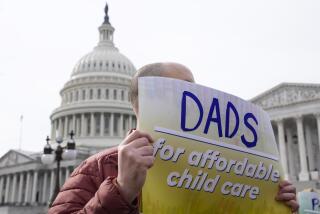Health Plan Would Break New Ground on Home Care : Aid: Package offers broad benefits for those no longer able to fend for themselves. Some see huge price tag.
- Share via
WASHINGTON — A nagging fear lurks in the minds of most older Americans: “What happens if I can’t take care of myself?” Their grown children, sometimes living far away with young children and worries of their own, wonder: “What can I do for Mom and Dad if they can’t take care of themselves?”
President Clinton’s health care plan promises some assistance for the millions of Americans asking these troubling questions.
If his proposal is enacted, a broad new benefit would pay for in-home help for individuals who can no longer fully take care of themselves in such areas as bathing, eating and getting dressed. The benefits would range from providing occasional assistance, such as installing “grab” bars in the bathtub, to hiring someone for several hours a day to help in the home.
But the proposal could open the door to huge new spending and to a government role in an area where family love and concern now handle the job. In addition, nobody knows just how many people are eligible and would avail themselves of such a program.
Federal programs have typically covered acute medical care: treating people with specific ailments at the doctor’s office or in the hospital. When there is custodial care for someone who is ill and frail without much chance of recovery, it takes place in a nursing home. The bills are paid through Medicaid, but this is a welfare program demanding impoverishment before a person becomes eligible.
With the health plan’s long-term-care benefit--which would provide cash to help with problems that don’t call for a doctor, hospital or nursing home--the Clinton Administration is seeking to win the backing of the middle class.
The goal is to keep the elderly at home and independent as long as possible.
“Many elderly and disabled Americans enter nursing homes and other institutions when they would prefer to remain at home,” a draft of the reform proposal said. “Families exhaust their resources trying to provide for disabled relatives.”
The benefit works this way: There are five key activities of daily living that typify a self-sufficient person. You must be able to get in and out of bed, use the toilet, bathe, get dressed and feed yourself.
The new benefit would provide financial help for those people needing assistance with at least three of those activities.
It would also be available for someone with cognitive impairment who can care for himself or herself but has dangerous memory loss, such as a victim of the early stages of Alzheimer’s disease.
There are 3.7 million Americans over the age of 65 who need help with one or more of these activities, according to a House report. Among those under 65, there are more than 1 million who need such help--including accident victims, some people with mental retardation, others with congenital problems such as cerebral palsy and those with chronic conditions such as multiple sclerosis.
The proposed benefit could finance a variety of services, including:
* Hiring someone to come to the home to help bathe and dress the person.
* Paying someone to do cooking and cleaning.
* Sending the person to an adult day-care center.
* Installing “grab” bars in the bathtub or shower.
* Having “respite care,” in which someone occasionally comes to the home to act as an adult baby-sitter in order to give the primary care-giver a break.
The government would give the states $80 billion between 1994 and 2000 for the new program, with the states deciding on eligibility.
The President proposes the benefit as a shared program, with the federal government generally paying 75% of the costs and the states picking up the balance. For poorer states, the federal share would go to 95%.
The plan calls for a sliding scale of contributions by the person getting help. There would be no federal charge for those with incomes up to 50% above the poverty line, although states could impose a nominal charge.
The rest of the population would be required to pay a portion of the cost, ranging from 10% to 40%, depending on income.
The program is not an entitlement, such as Social Security and Medicare, in which everyone who is eligible gets the benefit. Instead, it is linked to a specific pool of money, making it “first-come, first served.”
When the money is exhausted from the year’s budget at the state level, no more will be spent.
However, the history of federal social programs suggests that the demand will be greater than initially planned, and there will be tremendous political pressure to lift the dollar lid and guarantee outlays without limits.
No one knows for sure how many people with some limitations would have trouble with three of the activities of daily living. But it seems probable that doctors, nurses, social workers and any others who certify eligibility would be likely to offer a broad definition of who needs help.
Cynical experts call this the “woodwork effect,” suggesting that thousands and thousands of people will come out of the woodwork, demanding access to the new federal funds.
Currently, most care is provided by family members, usually women.
“Three-quarters of all care-givers are female--wives and daughters of persons needing care,” according to a House Ways and Means Committee report, which noted that more than 7 million spouses, adult children, other relatives, friends and neighbors spend some time giving help to elderly disabled people.
It’s impossible to estimate how much of this unpaid labor would be replaced with government-paid workers if the proposed benefit becomes a law.
But the only thing that seems likely is that the cost of such a new benefit would grow: By the year 2030, when the last of the baby boomers reach retirement age, there will be 13.8 million people needing help with daily living, the Ways and Means Committee estimated.
More to Read
Sign up for Essential California
The most important California stories and recommendations in your inbox every morning.
You may occasionally receive promotional content from the Los Angeles Times.










